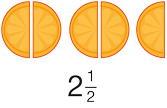Students use fraction circle pieces to model the addition of mixed numbers and to develop paper-and-pencil procedures.
Content in this Lesson
- Adding mixed numbers using circle pieces and paper-and-pencil methods [E8].
- Representing addition of mixed number fractions with fraction circle pieces [E3].
- Finding equivalent fractions [E1].
- Finding common denominators and using them to add mixed number fractions [E10].
- Solving word problems involving the addition of mixed number fractions [E5].
- Simplifying fractions to simplest form [E2].
- Estimating sums of mixed numbers [E9].
- Finding strategies for adding mixed numbers [MPE2].
- Checking for reasonableness [MPE3].
- Knowing the question to answer and what is important in a word problem [MPE1].
- Using labels to show what numbers mean [MPE6].
Assessment in this Lesson
| Assessment | Expectation Assessed | Math Practices Expectation Assessed |
|---|---|---|
|
Add Mixed Numbers |
|
|
|
DPP Item M |
|














 and
and  since 15 is divisible by both 3 and 5.
since 15 is divisible by both 3 and 5.  and
and  .
. ,
,  , and
, and  are improper fractions.
are improper fractions. .
.